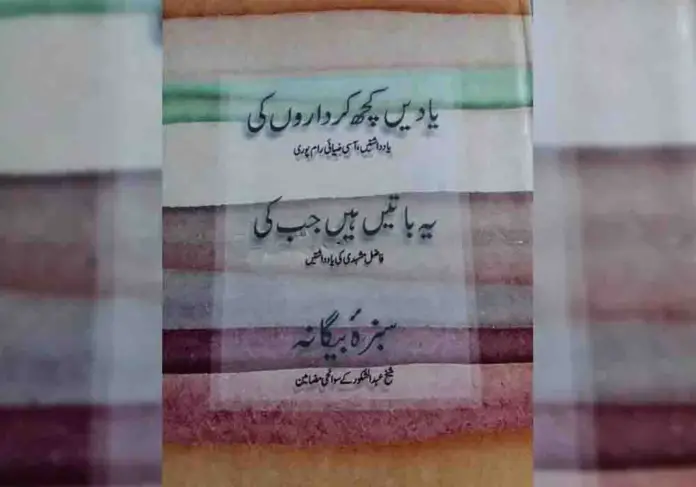Writing memoirs is not everyone’s cup of tea. Very few pick up the pen to write one. And fewer manage to do it honestly as most of the writers shy away from the truth and just beat about the bush. However, there are writers who have weaved the tales of the days gone by in such a frank and candid manner that readers have been left allured due to their unique way of presenting their respective narratives.
Under the banner of ‘Zinda Kitabein’, many old and forgotten memoirs are being reprinted to acquaint them with the new readers. Due to the sheer commitment and cooperation of Dr. Pervez Haider and Rashid Ashraf, the project ‘Zinda Kiatabein’ was initiated and many books were retrieved from the oblivion and published. Dr. Pervez Haider, a medical doctor by profession, fully supports the venture by helping the publication of the books, (mostly memoirs). Due to his largesse, the series is going strong and more than two hundred books have been printed so far.
The book under discussion consists of three short memoirs which have been compiled in one single volume. The first book, ‘Yaadein Kuch Kirdaaro’n Ki’, is penned by Aasi Ziae Rampuri which takes the readers back to the princely state of Rampur. It, as its title amply suggests, brings to life few unusual characters that once lived in Rampur state. There is a government official who strikes terror among the hearts of the people to collect the dues. Outwardly, he seems to wield terrorizing methods to get his job done but he rarely thrashes anyone. He just uses his reputation and performs his duties without harming anyone. There is a lovely essay on a mimic who has an extraordinary talent for mimicking others. He impersonates other people in such a perfect way that many a times, the situation turns into a hilarious episode. There is a motely of other characters whom Aasi Ziae Rampuri nostalgically remembers in this short yet memorable memoirs.
The second book in this volume is titled ‘Ye Baatein Hain Jab Ki’, authored by Fazil Mashhadi which also deals with an era of his growing up. He spent his early days in Jalandhar, Ferozpur but later shifted to Lahore in the 1920s. He got enrolled in Islamia College, Lahore and rubbed shoulders with literary and cultural titans of Lahore, which include Allama Iqbal, Hafiz Memood Shirani, Maulana Zafar Ali Khan and others. He used to enjoy the company of such luminaries and no wonder he was smitten by the literary bug also. He narrates a few memorable episodes of his stay in Lahore, where he permanently settled after 1947. His narrative ends there too. One wishes that the second part of his memoirs also sees the light of the day. Fazil Mashhadi’s pithy book must be read by all those who wish to get acquainted with the culture of Lahore from 1920s till 1947.
The third book is not less interesting either. ‘Sabza e Begaana’ by Sheikh Abdus Shakoor consists of the sketches of the few known and also the lesser known people he met. He too, belonged to the generation who grew up before partition and thus closely saw the bigwigs of art and literature. He skillfully paints a few alluring episodes of his times. He writes well about the socio-literary gatherings in Lahore. His powerful piece on a gathering in the historical Mubarak Haveli inside the city’s Mochi gate is a virtual treat to read.
He writes about a charlatan Pir Karam Shah who enthralls the gentry with his fake saintliness. He marries a beauty, daughter of Harry Nedous, the owner of Nedous Hotel where the WAPDA House of Lahore stands today. He makes her life a virtual hell and the author, with the help of other friends, helps the woman to escape. Later that lady marries the famous leader of Kashmir Sheikh Abdullah and one of her sons, Farooq Abdullah is a famous leader there now. Likewise, the essay on the highly sought after courtesan Gohar Jan is simply sterling.
All said and done, these three memoirs encased in a single volume are important historical documents as they reminiscence about a culturally rich period of our history. They should be read by all those who love digging out a past that is culturally rich but forlorn and forgotten.







